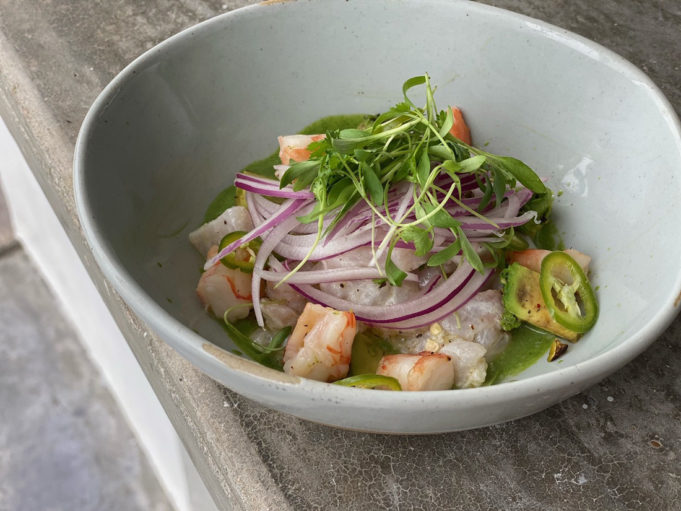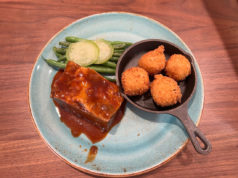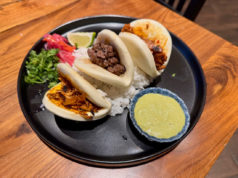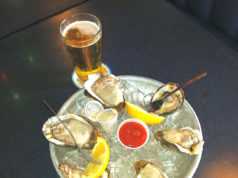Quince, 1701 River Run, Ste 181, FW. 11am-9pm Sun, 11am-10pm Mon-Thu, 11am-11pm Fri-Sat.
Far removed from the rolling hills of San Miguel de Allende — frequently named the “best city in the world” by publications such as Travel + Leisure and Condé Nast Traveler — renowned restaurant Quince migrated north of the border to open a second location in flat Fort Worth, where New Orleans native and owner Brian Sneed has lived since graduating from TCU in 1990. Since its San Miguel debut within eyesight of La Parroquia, the parish church that dates back to the 17th century, Quince was named the best rooftop restaurant destination in the world in 2018 and 2022.
Taking over the vacated BarTaco location along the Clear Fork branch of the Trinity River at WestBend, Quince has brought a slice of the Central Mexican highlands to our backyard. Don’t expect the authentic flavors of Central Mexico. Think global cuisine, here inspired by trips taken by Sneed and San Miguel chef Gonzalo Martinez.
On our recent visit, an overcast and light breeze held off any humidity, which made an early evening dining experience extremely agreeable. Other than an exchange of patio furniture, not much is different from the days of BarTaco, but having another outdoor option along the river is a welcome addition to the local dining scene. And with an occupancy limit of 150, the patio should be a year-round attraction.
A brief glimpse at the menu might cause some confusion as it reads like an upscale Applebee’s — all over the culinary map with hints of Japanese, Peruvian, Cajun, and, of course, Mexican. And while this typically goes against my anti-convolution mantra that restaurants maintain a focused menu and execute it well, I admit to being pleasantly surprised by Quince’s ability to capsize this.
The entrees — a lamb ragout, braised short ribs over hummus, truffle risotto, and a couple of fish options — tended to be less adventurous. Myriad steak cuts are listed along with a chicken sandwich and a hamburger because we’re still in Texas, but why play it safe when you can sample the creations birthed from the owner’s inspirational travels.
The starters — lamb barbacoa dumplings in a pool of cilantro sauce and aguachile de picaña (sliced roast beef and avocado habanero mousse) –– were more intriguing. Reminiscent of ceviche minus fish, the duck confit salpicon provided a well-balanced flavor. Tangy Thai chile sauce with hints of lime and cilantro complemented the slightly game-flavored bird served with fresh tortilla chips.
Three ceviches are offered under their own section, which leads to a robust selection of sushi, sashimi, and maki rolls. As we progressed, the divided options began to form a natural bridge with one another. Seafood began to take hold as the dominant ingredient among a majority of dishes.
Recommended by an attentive staff, the ceviche verde is reportedly a house favorite. Pillowy chunks of fresh shrimp and sea bass shared space with toasted avocado, all cohesively swimming in cilantro cream and a “leche de tigre,” traditionally a Peruvian marinade of fresh citrus juice, ginger, and turmeric. Other instances of Peruvian influence found their way onto Quince’s sushi menu. This relationship between the cultures started as Japanese immigrants found their way into Peru and the descendants became the mixed-race people commonly known as Nikkei, which saw flavors from both cultures collide. Shrimp marinated in harissa (a hot Arabic chile paste) also land a spot on the menu’s map.
Maintaining continuity with seafood, we ordered the panko-crusted sea bass, which was perfectly cooked and lightly flaky. The bomba rice of ginger and lemongrass provided the base, with ancho pepper cream to soak it up.
The stunner of the meal was the ancho-hibiscus blackened tuna, a dish I would typically pass over. In contrast with the sea bass, the dense tuna was cooked rare, and the crisped crust was a well-received difference in texture. The server drizzled the chipotle sauce around the dish, fortunately keeping the plate’s ingredients dry, which allowed us to dip when needed.
With prices mostly over $15 and settling in at $18, cocktails here are on the high side, and that was the only drawback we noted. Clearly, the price tags on the cocktails are geared toward the neighboring Colonial and TCU neighborhoods, but numbers like that can prevent customers with average incomes from repeat visits no matter how good the food is. Still, the beverages were delicious, especially the frothy carajillo and el dutch margarita, and the diablo margarita was superb and not as hellacious as expected.
Fort Worth’s food and beverage scene is going through a boom similar to that of a decade ago, and this is a positive attribute to our city’s growth. Just as the team behind Don Artemio chose Fort Worth for a second location, we are pleased that Sneed chose Fort Worth to bring a restaurant of this caliber to town — even before Austin gets their own later this summer.
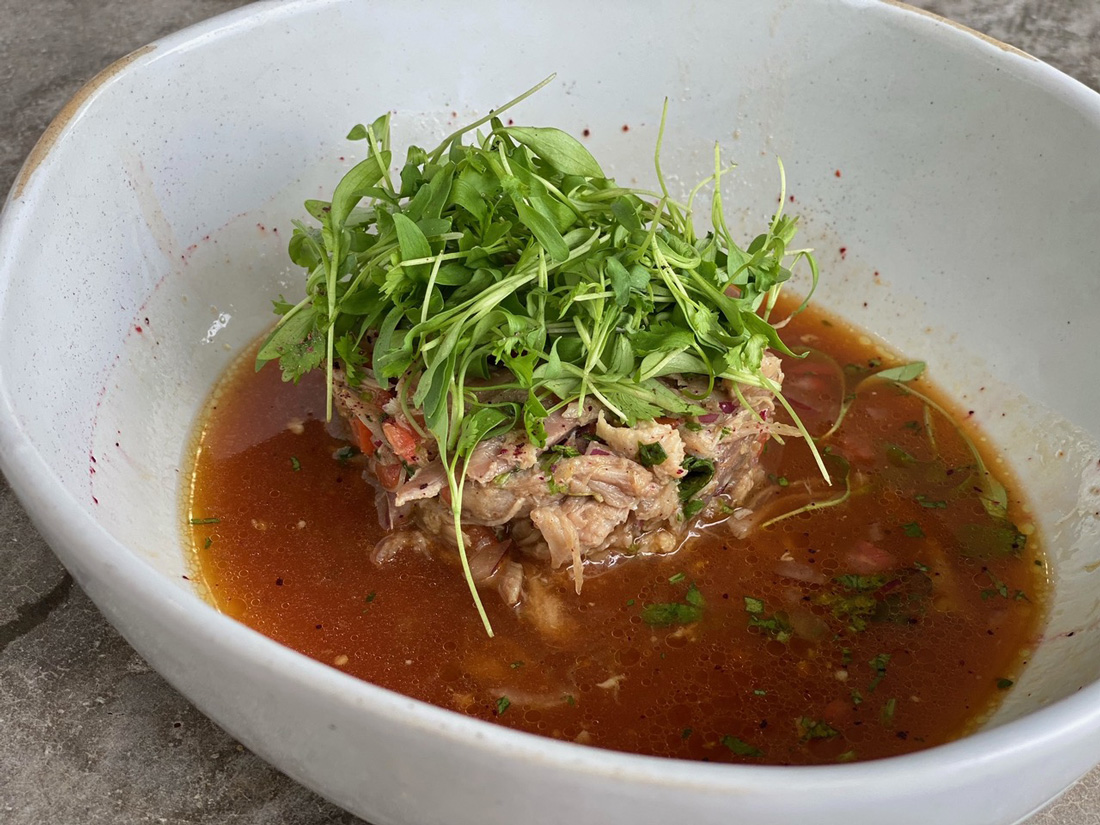
BY CODY NEATHERY
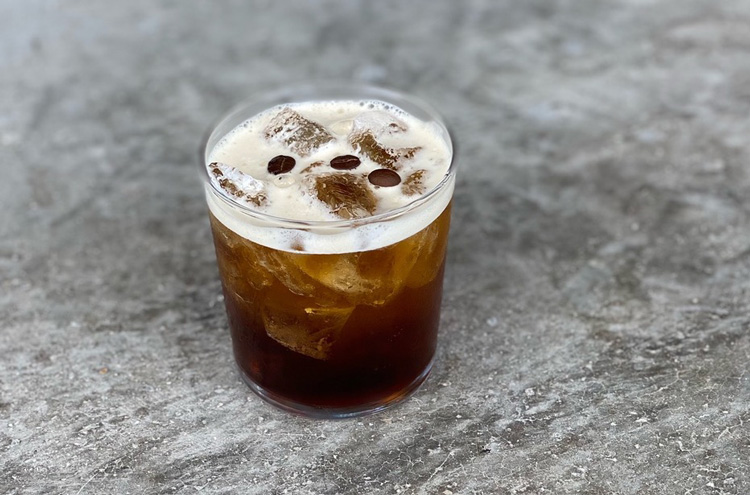
BY CODY NEATHERY



